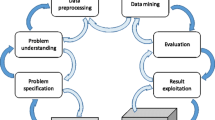Abstract
Correlations among the data attributes are abundant and inherent in most application domains. These correlations, if managed in systematic and efficient ways, would enable various optimization opportunities. Unfortunately, the state-of-art techniques are all heavily tailored toward optimizing factors intrinsic to relational databases, e.g., predicate selectivity, random I/O accesses, and secondary indexes, which are mostly not applicable to the modern big data infrastructures, e.g., Hadoop and Spark. In this paper, we propose the EXORD\(^+\) system for exploiting the data’s correlations in big data query optimization. EXORD\(^+\) supports two types of correlations; hard (which does not allow for exceptions) and soft (which allows for exceptions). We introduce a three-phase approach for managing soft correlations including: (1) validating and judging the worthiness of soft correlations, (2) selecting and preparing the soft correlations for deployment, and (3) exploiting the correlations in query optimization. EXORD\(^+\) introduces a novel cost-benefit model for adaptively selecting the most beneficial soft correlations given a query workload. We show the complexity of this problem (NP-Hard) and propose a heuristic to efficiently solve it in a polynomial time. Moreover, we present incremental maintenance algorithms for efficiently updating the system’s state under data appends and workload changes. EXORD\(^+\) prototype is implemented as an extension to the Hive engine on top of Hadoop. The experimental evaluation shows the potential of EXORD\(^+\) in achieving more than 10x speedup while introducing minimal storage overheads.

























Similar content being viewed by others
Notes
We use term “MapReduce” to refer to the system and architecture, and term “map-reduce” to refer to a single job executed in the system.
If \(\mathcal {V}_{ORD}\) is not empty, then each mapper needs to examine these correlations.
The system maintains few other configuration parameters that are omitted from the discussion.
The system dumps continuous reports on the queries that are optimized by correlation-based rewriting, the queries that are not optimized, the number of times a correlation is used to optimized queries. These reports enable system admins to tune the system as desired, or even manually trigger re-assessment using the “ASSESS CORRELATIONS ..” command.
References
Bohannon, P., Fan, W., Geerts, F., Jia, X., Kementsietsidis, A.: Conditional functional dependencies for data cleaning. In: IEEE ICDE, pp. 746–755 (2007)
Bonomi, F., Mitzenmacher, M., Panigrahy, R., Singh, S., Varghese, G.: An improved construction for counting bloom filters. In: 14th Conference on Annual European Symposium, pp. 684–695 (2006)
Brown, P., Haas, P.J.: BHUNT: automatic discovery of fuzzy algebraic constraints in relational data. In: VLDB, pp. 668–679 (2003)
Bu, Y., Howe, B., Balazinska, M., Ernst, M.D.: Haloop: efficient iterative data processing on large clusters. Proc. VLDB Endow. 3(1–2), 285–296 (2010)
Chen, S.: Cheetah: a high performance, custom data warehouse on top of mapreduce. Proc. VLDB Endow. 3(2), 1459–1468 (2010)
Chu, X., Ilyas, I.F., Papotti, P.: Discovering denial constraints. PVLDB 6(13), 1498–1509 (2013)
Dittrich, J., Quiané-Ruiz, J.-A., Jindal, A., Kargin, Y., Setty, V., Schad, J.: Hadoop++: Making a yellow elephant run like a cheetah (without it even noticing). VLDB 3, 518–529 (2010)
Elghandour, I., Aboulnaga, A.: Restore: reusing results of mapreduce jobs. Proc. VLDB Endow. 5(6), 586–597 (2012)
Eltabakh, M.Y., Özcan, F., Sismanis, Y., Haas, P., Pirahesh, H., Vondrak, J.: Eagle-eyed elephant: split-oriented indexing in hadoop. In: Proceedings of the 16th International Conference on Extending Database Technology (EDBT), pp. 89–100 (2013)
Eltabakh, M.Y., Tian, Y., Özcan, F., Gemulla, R., Krettek, A., McPherson, J.: Cohadoop: flexible data placement and its exploitation in hadoop. PVLDB 4(9), 575–585 (2011)
Fan, W., Geerts, F., Jia, X., Kementsietsidis, A.: Conditional functional dependencies for capturing data inconsistencies. ACM Trans. Database Syst. 33(2), 6:1–6:48 (2008)
Haas, P.J., Naughton, J.F., Seshadri, S., Stokes, L.: Sampling-based estimation of the number of distinct values of an attribute. In: Proceedings of the 21st International Conference on Very Large Data Bases, pp. 311–322 (1995)
Huhtala, Y., Kärkkäinen, J., Porkka, P., Toivonen, H.: TANE: an efficient algorithm for discovering functional and approximate dependencies. Comput. J. 42(2), 100–111 (1999)
Ibarra, O., Kim, C.: Fast approximation algorithms for the knapsack and sum of subset problems. J. ACM 22, 463–468 (1975)
Ilyas, I.F., Markl, V., Haas, P., Brown, P., Aboulnaga, A.: Cords: automatic discovery of correlations and soft functional dependencies. In: In SIGMOD, pp. 647–658 (2004)
Jiang, D., Ooi, B.C., Shi, L., Wu, S.: The performance of mapreduce: an in-depth study. Proc. VLDB Endow. 3(1–2), 472–483 (2010)
Kimura, H., Huo, G., Rasin, A., Madden, S., Zdonik, S.B.: Correlation maps: a compressed access method for exploiting soft functional dependencies. PVLDB 2(1), 1222–1233 (2009)
Kimura, H., Huo, G., Rasin, A., Madden, S., Zdonik, S.B.: CORADD: correlation aware database designer for materialized views and indexes. PVLDB 3(1), 1103–1113 (2010)
Liu, H., Xiao, D., Didwania, P., Eltabakh, M.Y.: Exploiting soft and hard correlations in big data query optimization. Proc. VLDB Endow. 9(12), 1005–1016 (2016)
Liu, Y., Liu, H., Xiao, D., Eltabakh, M.Y.: Adaptive Correlation Exploitation in Big Data Query Optimization. Technical Report: http://web.cs.wpi.edu/~meltabakh/WPITR1803.pdf
Nguyen, H.V., Müller, E., Andritsos, P., Böhm, K.: Detecting correlated columns in relational databases with mixed data types. In: SSDBM, pp. 30:1–30:12 (2014)
Nykiel, T., Potamias, M., Mishra, C., Kollios, G., Koudas, N.: Mrshare: sharing across multiple queries in mapreduce. Proc. VLDB Endow. 3(1–2), 494–505 (2010)
Svitkina, Z., Fleischer, L.: Submodular approximation: sampling-based algorithms and lower bounds. SIAM J. Comput. 40(6), 1715–1737 (2011)
The Apache Software Foundation. Hadoop. http://hadoop.apache.org
Thusoo, A., Murthy, R., Sarma, J.S., Shao, Z., Jain, N., Chakka, P., Anthony, S., Liu, H., Zhang, N.: Hive–a petabyte scale data warehousing using hadoop. In: ICDE (2010)
Ullman JD.: Principles of database and knowledge-base systems, Vol. 1, Computer Science Press, Inc. (1988)
Zaharia, M., Chowdhury, M., Franklin, M.J., Shenker, S., Stoica, I.: Spark: Cluster computing with working sets. In: USENIX Conference, pp. 10–10 (2010)
Author information
Authors and Affiliations
Corresponding author
Additional information
This project is partially supported by NSF-CRI 1305258 Grant.
Rights and permissions
About this article
Cite this article
Liu, Y., Liu, H., Xiao, D. et al. Adaptive correlation exploitation in big data query optimization. The VLDB Journal 27, 873–898 (2018). https://doi.org/10.1007/s00778-018-0515-8
Received:
Revised:
Accepted:
Published:
Issue Date:
DOI: https://doi.org/10.1007/s00778-018-0515-8




